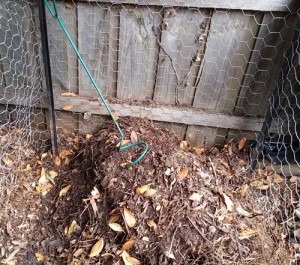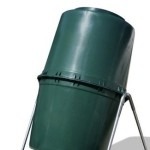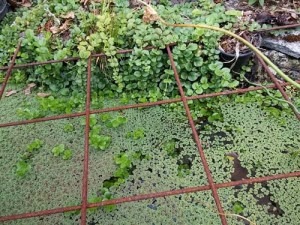In a previous article we explored ways that gardeners can lock up carbon in the soil. Although increasing soil carbon is important, it doesn’t address ways of dealing with greenhouse gases that are talked about less often, namely, methane and nitrous oxide. Fortunately, the approaches to reducing emissions of these gases also lead to better soil structure and fertility.
Methane
This gas, with the chemical formula CH4, (i.e. each molecule contains one carbon atom) is worrisome because it is 25 times more potent than carbon dioxide in its global warming impact, weight for weight. However, it decays more rapidly in the atmosphere than carbon dioxide. It is produced naturally from wetlands and as a result of the digestive processes of ruminant animals (cows and sheep). It also leaks from natural gas systems.1
The major pathway for methane to be generated by gardening activities is through breakdown of organic matter in anaerobic conditions i.e. when oxygen is excluded. Gardeners may cause extra methane to be added to the atmosphere by some methods of composting and making weed “tea”, soil compaction and poor pond maintenance.
Composting
We all want compost, don’t we? But significant amounts of methane can be produced in the centre of compost heaps as material is broken down and the temperature rises. Methane production appears to be due to the density of the heap so that oxygen cannot penetrate and anaerobic microorganisms are favoured. To reduce this problem the heap needs to be well aerated. You can do this by:
 Making your own compost bin or bay out of material that lets air through i.e. not solid plastic. Suitable materials are timber slats, logs or trellis or chicken wire.
Making your own compost bin or bay out of material that lets air through i.e. not solid plastic. Suitable materials are timber slats, logs or trellis or chicken wire.- Building the heap with a wooden pallet as the base. This gives some air space under the heap.
- Adding material such as straw that doesn’t get compacted so easily.2 Make sure that there are plenty of dried leaves, twigs and other fibrous materials in the heap. These are best added in layers with the amount of dry material about equal to the amount of wet/green.
- Including vertical aerating tubes as you build the heap. These can be made from tightly rolled chicken wire or PVC pipe with lots of holes drilled into it. Such devices have the added advantage of making it easy to get water into the centre a heap which is drying out.
- Using a tumbling device.
- There are a number of different designs for tumblers commercially available. If these are rotated every day or
 so, they will aerate material satisfactorily. However, they sometimes lead to lumps which can get aerobic, if enough dry material is not added at the same or, indeed, mixed with the wet material before adding it. Actually turning the tumbler can be a problem since it can get quite heavy.
so, they will aerate material satisfactorily. However, they sometimes lead to lumps which can get aerobic, if enough dry material is not added at the same or, indeed, mixed with the wet material before adding it. Actually turning the tumbler can be a problem since it can get quite heavy. - For a thorough coverage of managing a tumbler see www.the-compost-gardener.com/composting-tips.html
- If all else fails, you can engage in some physical exercise and turn the heap regularly. You can do this with a garden fork (easier than a shovel), but it can be backbreaking work. There are various compost turning tools available now, such as one which looks a bit like a large corkscrew. It twists down easily and then you can pull out a plug of material from further down the heap.
Making weed “tea” under anaerobic conditions
Here is a dilemma. In a previous article we explored how to make compost, worm and weed teas to produce soluble fertilizer and discussed how the solid material needs almost constant stirring to avoid anaerobic conditions. We also pointed out that it may be easier for home gardeners to use the anaerobic method with only occasional stirring. Given that this method favours methane production, you might have a bit of a debate with yourself about the relative costs and benefits of each method or choose other ways of processing garden waste such as solarizing or composting.
Compacting soil
This happens by placing heavy weights on it e.g. heavy machinery or walking. Compaction removes the air spaces which aerobic microorganisms need for their oxygen supply. It is less likely to happen in raised garden beds and if the bed width is limited to about 1 metre so that you can reach across.
 Pond Maintenance
Pond Maintenance
Ponds can become anaerobic if the water gets very murky or if the surface gets too much growth of water weeds such as Azolla3 as in the image on the right. These conditions can limit light entry so that submerged oxygenating plants are killed. Adding unsuitable fish species which stir up sediment can have a similar effect.
Nitrous oxide
Although it does not contain carbon atoms, nitrous oxide, N2O, is 298 times more potent as a greenhouse gas than carbon dioxide, but is shorter lived, persisting in the atmosphere for 114 years. So we should not just think about carbon emissioins from gardening!
It has been calculated that 40% of emissions of this gas in the USA come from human activities with about 70% of that derived from agricultural land management. Nitrous oxide also happens to be the most important gas contributing to the hole in the ozone layer now that halocarbon levels are declining.
To reduce extra nitrous oxide being emitted we can:
- Use manures and other organic sources of nitrogen rather than synthetic nitrogen fertilisers and apply them carefully so that there is not excess nitrogen for plant use – that means not applying them when plants are not actively growing. Synthetic nitrogen fertilisers also contribute to making soil more acid.
- Since acid conditions encourage biochemical pathways that produce nitrous oxide, if soil pH is low we can add lime or dolomite.
- Use no-dig methods to avoid soil disturbance.
- Turn garden waste into compost or mulch rather than burning it.
- Avoid working soil when it is wet as this assists compaction which creates conditions in which soil micoorganisms convert nitrates to nitrous oxide.
References
- Reay D, Smith P, van Amstel A. 2010. Methane and Climate Change. London: Earthscan. ISBN978-1844078233.
- Sommer SG, H. B. Moeller. 2000. Emission of greenhouse gases during composting of deep litter from pig production – effect of straw content. 2000. J. Agricultural science 134 (3) 327-335.
- Rachel A, Janes JW, Eaton K . 1996. The effects of floating mats of Azolla filiculoides and Lemna minuta Kunth on the growth of submerged macrophytes. Hydrobiologia 340 (1) 23-26.
Related Articles:
Weed Control
Several different approaches are needed for weed control since eradication is difficult and can be expensive. Preventing weeds from establishing and…
Low Impact Pest Management 101 Video
Sustainable Gardening 101 Video Series PART 3: Low Impact Pest Management Gardens are the natural habitat for all types of insects – the good, the…


